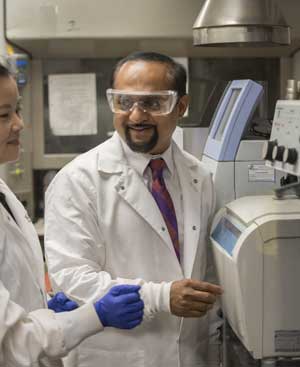| Posted: Apr 12, 2017 |
Newly funded nanoparticle research project targets abdominal aortic aneurysms
(Nanowerk News) One of the top ten killers for men older than 55 is the target of Clemson University research that could lead to a new life-saving therapy and a better way of telling whether surgery is necessary.
|
|
Naren Vyavahare, who holds the Hunter Endowed Chair, has received $1.47 million from the National Institutes of Health to advance research into abdominal aortic aneurysms. When they rupture, the aneurysms are fatal 75-90 percent of the time without immediate hospitalization, he said.
|
 |
| Naren Vyavahare of Clemson University is working on new ways of treating and diagnosing abdominal aortic aneurysms.
|
|
About 200,000 people in the United States are diagnosed each year with an abdominal aortic aneurysm, often called AAA, according to the Society for Vascular Surgery.
|
|
While Vyavahare's work is at least 10 years from market, he hopes it could eventually ease anxiety and prevent surgery for thousands of patients. More than 70,000 surgeries are performed each year, he said.
|
|
"When someone finds an aneurysm, it's a time bomb sitting in your stomach," Vyavahare said. "Our research could lead to a new therapy. Right now, the only therapy is a vascular graft, which is surgical treatment. We are thinking, 'Can a patient have a systemic therapy, such as an injection they can take?'"
|
|
Vyavahare has two aims in the research, both using specially engineered nanoparticles that are 250-fold smaller than the width of a human hair and circulate through the bloodstream.
|
|
One aim is to develop a new treatment. The nanoparticles would attach to the aneurysm and deliver the chemical compound pentagalloyl glucose (PGG). Previous studies in animals have shown that PGG stabilizes and shrinks aortic aneurysms, making them less likely to rupture.
|
|
Another aim is to improve diagnosis. Vyavahare is also using gold nanoparticles to develop a new way of creating medical images that could identify aneurysms' weak spots, helping tell if surgery is necessary. The gold nanoparticles would accumulate at the damaged tissue so that a CT scan could help give a better diagnosis of weakened tissue.
|
|
"Imaging can give you the option--maybe you should go for therapy or maybe you need surgery if it's too weak and you can't wait," Vyavahare said.
|
|
An abdominal aortic aneurysm is a balloon-like bulge in the aorta, the body's main artery. It runs from the heart to the abdomen, distributing oxygenated blood throughout the body.
|
|
An aneurysm is caused by a thinning and weakening of the vessel wall. High blood pressure, high cholesterol, hardened arteries and smoking are risk factors for aortic aneurysm, according to the Centers for Disease Control and Prevention.
|
|
The statistics are grim when the aneurysm ruptures. It's the 15th leading cause of death in the country, and the 10th leading cause of death in men older than 55, according to the Society for Vascular Surgery.
|
|
The nanoparticles in Vyavahare's research are coated with an elastin antibody, causing them to attach to the degraded elastin, a protein in the aneurysm.
|
|
Vyavahare described elastin as the "rubber band of life" and said it's the body's version of elastic material, making it possible for arteries to push blood forward. Inflammatory conditions in aneurysms lead to elastin degradation.
|
|
When carried by nanoparticles, a small amount of PGG can be used to stabilize and restore elastin. Without the nanoparticles, so much PGG would be needed that it would be toxic.
|
|
Martine LaBerge, chair of the Department of Bioengineering, said the grant, an R01, was well-deserved.
|
|
"Dr. Vyavahare is a leading researcher in his field with more than 20 years' experience," she said. "His background in chemistry combined with his clinical experience uniquely qualifies him to lead this project."
|
|
Doctors face difficult decisions when deciding whether the risk of aneurysm rupture justifies surgery because patients are often elderly and have other health issues. Vascular grafts are typically recommended when aneurysms reach 5 centimeters in diameter.
|
|
The diameter increase is monitored with ultrasounds and CT scans that are often enhanced with large amounts of iodinated contrast agents. The toxicity of those agents have been debated, and the scans do not provide information about the extent of aortic wall damage.
|
|
Vyavahare sees the gold nanoparticles as a promising substitute for the iodinated contrast agents. Only a small amount of gold nanoparticles would be needed, he said. They would go only to the degraded elastin, allowing doctors to get vital information about the extent of damage.
|
|
Vyavahare's work has also raised hopes that nanoparticles could be used to treat other ailments involving elastin degradation, including chronic obstructive pulmonary disease, commonly called COPD.
|
|
A Clemson group that included Vyavahare used the nanoparticles to successfully deliver the drug doxycycline to rats with emphysema, which is often a part of COPD. The research showed promise as a way of controlling inflammation, halting further damage to the lungs.
|
|
That research was reported in the journal Pulmonary Pharmacology & Therapeutics ("Targeted drug delivery to emphysematous lungs: Inhibition of MMPs by doxycycline loaded nanoparticles"). The next step is to try the method in larger animals, Vyavahare said.
|
|
Anand Gramopadhye, dean of the College of Engineering, Computing and Applied Sciences, said that Vyavahare's research is helping engineer better medicines, one of the grand challenges identified by the National Academy of Engineering.
|
|
"The award is a testament to his innovative approach, years of hard work, and the results he has produced," Gramopadhye said. "I congratulate Dr. Vyavahare on this well-deserved grant."
|

